09.24.2010 | 9:40 am
About a year ago, Dustin at Shimano helped me give away a mind-boggling road bike to help Team Fatty raise money for our fight against cancer.
An Orbea Orca, equipped with the new outrageous technological marvel from Shimano: Dura-Ace Di2: the electronic shifting group. Not to mention Dura-Ace carbon tubeless wheels and PRO components.
A dream bike’s dream bike. Easily worth around $10,000.
And then, after the contest, Dustin did me another huge favor: he helped me get the exact same bike for myself.
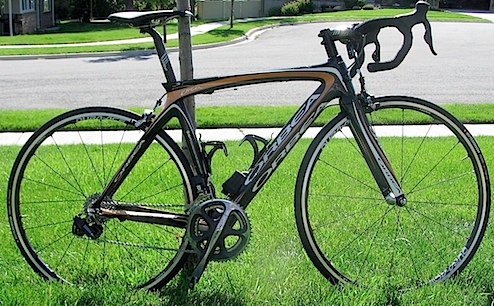
And now, after having ridden this bike for a year, I have no problem whatsoever saying that I am totally, hopelessly elatedly in love with both the Orbea Orca and the incredible — yes, I mean incredible — Di2 shifting group.
And I’m giddy that I get to announce that — in the name of our fight against cancer — we are going to once again have a contest to win this bike.
But this time, it’s the new 2011 version:
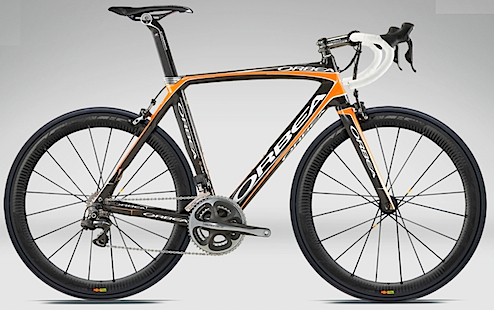
That’ right. You can win the beautiful, strong, light (I’ll talk about each of these adjectives in a minute) 2011 Orbea Orca, outfitted with the most incredible set of components imaginable, all by joining Team Fatty in our fight against cancer. Read on to find out how, or just head on over to my LiveStrong Challenge Page to enter now.
And that’s not the only reason you should enter. Because — get this — thanks to my good friends at Twin Six, I’m also giving away a trip for two to Austin to join me and the rest of Team Fatty for the Ride for the Roses.
But first, I’m going to tell you about why I love my own Orbea Orca with Shimano Dura-Ace Di2.
What I Love About the Orca
I don’t even know how many times people have stopped me to just ogle my Orbea Orca (check out some photos here).
It’s just a gorgeous bike. Sculpted without getting wacky. Functional and elegant.
It’s a joy to look at, frankly.
But it’s not simply a looker. The front end is unlike anything i have ever experienced on a bike. never realized how stiff a bike’s front end could be until I rode the Orca for the first time.
And I have never been so fast on the road as I am on this bike. I am a faster climber. Part of that’s because this bike is easy to build at under 16 pounds. More importantly, though, power transfer with the Orca is amazing.
And on the descents, I am faster than ever before. This bike makes me feel stable and confident.
Of course, these things are all true for the 2010 edition of the bike, which is what I own. For 2011 — the bike we’ll be giving away with this contest — the Orca keeps the stiffness I love, but gains smoothness. It’s more aerodynamic, and the winner will get a special version of the frame with internal routing.
Oh, and did I mention it’s going to be beautiful? Cuz it is.
What I Love About Shimano Di2
Electronic shifting. People who haven’t tried it are often quick to dismiss it. After all, non-electrong shifting works just fine, right? So why would you need or want the Shimano Di2 group?
People who have actually ridden and lived with the Di2 group, on the other hand, don’t ask that question. Here are some of my takeaways from my experience with riding with Dura-Ace Di2:
- Shifting is practically effortless. A quick tap of the right buttons — which are placed so as to feel perfectly natural to those of us who are used to traditional shifting — makes the gear change. Perfectly. Every time. Ever since messing up my left wrist a few years ago, going to the big ring with old shifters hurts. And for anyone, if you don’t make the shift throw correctly, you’re likely to drop your chain. I have never ever dropped the chain with Di2. Perfect shifts every time.
- Shifting is so fast and perfect. I can go up and down the cassette at crazy speeds with Di2, and I can move from the small to big ring (and back again) in no time at all. And I can do it no matter what the gradient is or how much stress I’m putting on the pedals. Shifting is in service to me, instead of the other way around.
- Shifting is maintenance-free. You’d think that electronic shifting would require more hassle on my part, but the reverse has been true. I have had to do no maintenance of the Di2 system. Cable stretch is not a problem. The derailleurs never get out of alignment — they shift as crisply and perfectly now as on day 1. It’s just amazing.
- Auto-trim is awesome. When you shift — front or rear — the front derailleur makes instant, tiny adjustments to keep the chain perfectly aligned. It’s brilliant.
- The battery lasts for months. I was initially worried that I’d have to charge the battery every couple of rides. Or at least once a week. But even with several rides per week, I only have to charge the battery every few months. I wish my phone would go that long between charges.
- I love the R2D2 sound. When you shift, you get a cool “bwwwrp-zzp” sound as the motors move the derailleurs. I love this sound so much I sometimes shift just to hear it. Really.
I should also mention that I also love the Shimano Dura-Ace Carbon Tubeless wheels. So light. So fast. And since I only have to inflate them to 80psi, the comfort on the road — not to mention handling — is just off the charts.
Honestly, this bike is just perfect. It’s like nothing I’ve ever owned.
And now, if you help out Team Fatty as we raise money for the fight against cancer, you have a chance at winning one for yourself.
Specifically — and I’m going to go with bold for the rest of this paragraph — you will get a 2011 Orbea Orca, outfitted with the Shimano Dura-Ace Di2 group, Dura-Ace Wheels, and an a full complement of PRO components. A bike which would retail for between $10,000 and $12,000.
Wow.
How You Can Win
Oh, you think you’d like to have this bike? Well, of course you would. Well, to win it, you’re going to need to do a little cancer fighting with me. Here are the ways you can donate.
- By Donating at my Austin LiveStrong Challenge Page: For every $5 you donate at my LiveStrong Challenge page, you get another row on my spreadsheet. That DOES NOT mean that if you want to donate $50, you’ve got to do ten $5.00 donations. I’m awesome at Excel and will be able to give you the correct number of chances automatically, based on how much you donate. Click here to donate now .
- By Raising Money at Your OWN Team Fatty LiveStrong Challenge Page: If you’re a member of Team Fatty, now’s a great time to donate money to your own LiveStrong Challenge, as well as to get others to donate to it. For every $5 you raise between the beginning of the year to the end of the contest, you get another chance at this bike.
The contest ends Friday, October 1, at Midnight, MDT. At that point I will choose a winner at random from my spreadsheet, using random.org to pick the lucky person. I will then fire off an email to the winner. Once I get acknowledgement, I’ll announce it on my blog, and you can begin collecting envious looks.
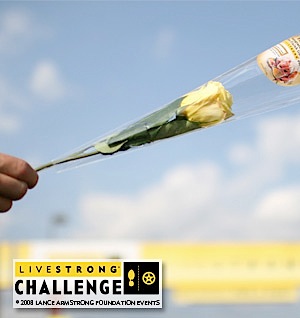 You Can Also Win a Trip to Austin to Join Team Fatty for the Ride for the Roses
You Can Also Win a Trip to Austin to Join Team Fatty for the Ride for the Roses
As if winning a $10,000 bike isn’t enough, I now have another grand prize with this contest. Some lucky person who donates at my LiveStrong Challenge page will win a trip for two to the Ride for the Roses. You will be treated at the “yellow jersey” level, getting:
- Airfare (within the US) for the two of you
- 3-night hotel stay
- Sunday ride front starting line position
- Ride for the roses jacket and jersey
- Access to the Sunday hospitality tent
And you’ll — most importantly — get to hang out with the rest of Team Fatty at this event.
How am I able to give away this prize? Simple: my good friends at Twin Six are giving up their hard-earned spots. They say that they got to go last year and now they want to give that opportunity to someone else.
Honestly, these are the nicest guys in the world.
Donate Now
With an amazing bike and an amazing trip as grand prizes, this is a huge contest. And a couple of lucky people are going to get these incredible prizes.
But, chances are, you won’t win. And that’s totally fine. Because — whether you win or not — you will have contributed money to LiveStrong, and you’ll have helped in the fight against cancer. And that matters.
So, head to my LiveStrong Challenge page and donate. Or join Team Fatty and start raising money on your own LiveStrong Challenge page. Either way is a great way to win, and a meaningful way to help in the fight against cancer.
Good luck!
Comments (57)
09.24.2010 | 7:21 am
I’d like to kick this weekend off by posing a couple of questions. These questions are real philosophical humdingers. These are questions that are going to make you tug at your beard (whether you have one or not) and gaze — unfocused — into the sky.
These are questions that — with any luck — will compel you to write clever responses in the comments section.
In order for you to understand and answer these questions, you must first look at this photograph (click to see a larger version):
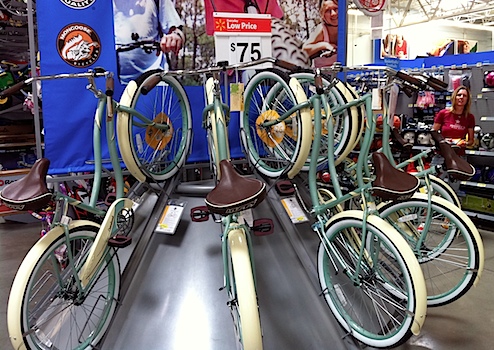
Now, before I get to my questions, I’d like to point out some important facts you’ll need:
- These bikes are new.
- These bikes are at Walmart.
- These bikes cost $75, each.
- That’s The Runner at the far right side of the picture, wondering why I’m taking a photograph of these bikes.
The Big Questions
So now, armed with the knowledge you need, I would like you to now consider and then respond to the following questions:
- As with anything, the law of diminishing returns applies to bicycle purchases; a $30,000 bike is (probably?) not going to be three times as awesome as a $10,000 bike. But does that law apply in the opposite direction? Which is to say, is a $75 bike only going to be 1% as fun to ride as a $7500 bike? Explain your answer.
- Which would give you more trouble-free hours on a bike: buying one $7500 bike, or buying a hundred $75 bikes (i.e., when one $75 bike breaks you walk away from it and get out the next one)? I’m genuinely interested in your answer on this one.)
- Which would be the more awesome spectacle: one person riding a $7500 bike down the road, or a procession of a hundred people riding identical $75 bikes down the road? This question is mostly rhetorical.
- If we take for granted that a $75 bike is not suitable for most traditional cycling purposes (e.g., going somewhere), what are suitable purposes for $75 bikes? Be creative.
I anticipate your answers with great anticipation.
Comments (129)
09.23.2010 | 12:25 pm
Today is my third installment in my “Stuff Fatty Loves” series, wherein I talk about bike-related things I can, without reservation, recommend. And I am pleased — no, delighted — to announce that today’s lovable thing is soft serve ice cream.
What? You wonder how soft serve ice cream is a bike-related item? Well, to you I say: pffff. There’s nothing in the world more bike-related than soft serve. Except perhaps a bike. But my point stands. Or it will stand, after I prop it up a bit.
Which I will do right now. In a roundabout way.
Lucky Accident
I live in Alpine, Utah, about as close to American Fork Canyon as you can without actually taking up residence in the little toll booth at the mouth of the canyon. This is not by accident, because I knew before I moved here exactly how perfectly suited to both road and mountain biking American Fork Canyon is.
However, I did not consider when moving here that American Fork Canyon is also home to the Timpanogos Cave National Monument.
But if I had considered that, I would have wanted to move here even more. Because the Timp Cave Visitor Center — which you must pass, whether you’re mountain biking or road riding — has a nice little concession stand.
And that concession stand has vanilla soft serve ice cream for sale. For $0.89, you can, on the way home from a mountain or road ride, get yourself a cool little coneful of heaven.
After you’ve been riding in the heat for hours, nothing in the world sounds quite so perfect as something cool, creamy, and caloric. You’re just sitting outside, relaxing in the shade, still near the mountain that you love, licking the ice cream fast enough to keep it from melting, but not so fast that it gives you an ice cream headache.
There have been times when, for the last half hour of a ride, all I can think about is that soft serve. Where I’ve been asking myself — with all the focus and intensity as if I’m considering the meaning of life — whether I’ve got a debit card or paper money with me. Or — failing that — whether I’ve got enough change in my vehicle to cover a cone.
The Beauty of Soft Serve
It’s possible you’re wondering what the big deal is. “It’s just ice cream,” you might claim. Or maybe even, “Soft serve isn’t even great ice cream — why get attached to soft serve in a world that contains Ben & Jerry’s New York Super Fudge Chunk?”
Those are reasonable objections. And my responses to those objections are really what makes soft serve ice cream a bike-related thing I love.
I shall enumerate. Using numerals and everything.
- Consistency. Soft serve is — this should come as no surprise — soft. Either during or after a ride, when I’m really cooked, ice cream that is already practically pre-melted for me is perfect. Hard ice cream is too much effort; I prefer to just lazily lick around the cone. Plus, because it isn’t as cold as regular ice cream, it doesn’t freeze your taste buds. Which means you taste it better.
- The other consistency. No matter where you get it, soft serve is pretty much the same thing. No weird surprises. You can be riding anywhere, stop at an unfamiliar place and get a soft serve cone and be certain it’s going to be what you want.
- Near-ubiquity. Chances are, if you go riding past any fast food restaurant, you’ve got access to soft serve.
- The cone. Soft serve generally comes in a cake-style cone — the whiteish, flat-bottomed cones. I love these cones as much as the ice cream itself.
- The ritual. Everyone eats their soft serve in their own particular way, and I’m not here to judge your way. The important thing is, everyone really does eat their soft serve in their own way — the same way — every single time, and it’s a magnificent expression of self. As for myself — I know you’re curious — I go for sideways licks, spiraling from the top to the bottom of the cone, rotating the cone as I go, and always monitoring for drips onto the cone itself. Once I have gotten the ice cream perfectly level with the cone, I bite away the first level of the cone, then repeat the original process. Once the ice cream is level with the remainder of the cone, I bite off the top half. I then pop the bottom half into my mouth.
- Time. A soft serve cone takes about five minutes to eat — just about the right amount of time for a ride break or to cool down after a ride.
Problem Areas
There are, sadly, some trouble spots with soft serve. The most important one for me is that my body has evidently decided that the primary purpose of dairy products is as a catalyst for fart production. I have resolved this problem to my satisfaction, however, by rationalizing to myself that as long as I have just one cone, my gassiness won’t be that bad.
Which I’m sure everyone agrees with wholeheartedly.
The next problem with soft serve is in quantity. Specifically, there are some ice cream servers who are too generous. Yes, I know it sounds weird, but I don’t like it when I buy a cone and get eight inches of ice cream towering precariously atop my cone. For one thing, that much ice cream is going to compound the gassiness problem. For another, the chances of my successfully eating that much soft serve without it becoming a melty mess is poor at best. And of course, the likelihood of the ice cream tower toppling from the cone is very high, which means I will — in a slow-motion split second — likely go from having too much ice cream to having too little.
Thus, I hereby declare that the correct dimensions for the soft serve above the cone are as follows:
- The diameter of the ice cream shall not exceed the diameter of the widest point of the cone by more than 1/2″. Nor shall it be any narrower than the widest point of the cone.
- The height of the ice cream shall be the same height as the cone itself, plus or minus 1/2″. Thus giving the soft serve cone a pleasing symmetry.
I do not, by the way, want to come off as some bourgeois soft serve snob; I fully recognize that serving a well-balanced soft serve cone takes talent and practice. Seeing a well-formed cone always makes me envious; any attempts I have ever made at serving soft serve have been miserable failures.
Vanilla vs. Chocolate vs. Twist
Most soft serve machines have three options: chocolate, vanilla, and twist (ie, a combination of chocolate and vanilla).
Allow me to recommend that — even if you really like chocolate — you always go with straight-up vanilla. I say this because while the vanilla flavor is in fact very vanilla, the chocolate flavor is not really very chocolate-y.
And buying twist just means that you’re wishy-washy and indecisive. Don’t buy twist.
Wrapping Up
In conclusion, I love soft serve ice cream, and am satisfied that I have managed to — somewhat weakly perhaps — tie it to cycling.
Comments (50)
09.22.2010 | 3:21 pm
A Full Disclosure Note from Fatty: I bought my Garmin Edge 500 from an online retailer and got no special discount on it.
Remember when bike computers had a thin little wire that ran down to your fork, where the sensor would pick up as the little magnet you attached to a spoke went by?
Except, of course, when the magnet moved and started hitting the sensor with every rotation of the wheel. Click click click click click.
Or when the sensor moved and stopped picking up the magnet.
Or when the wire broke.
Or when the battery died, in which case you would need to — since of course the battery was a completely unique size — order replacements from the manufacturer for just slightly more than the original cost of the bike computer itself, plus $8.00 for shipping. Please allow 8 weeks for delivery.
Yeah, those were the good old days.
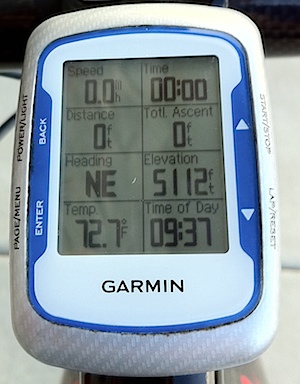 Dawn of the GPS
Dawn of the GPS
And then — maybe seven or eight years ago? — affordable GPSs came out. They were just about the same size as mobile phones, which is to say about the size and weight of a brick. Four AA batteries would very nearly get you through a three-hour ride. Provided, of course, you didn’t break the giant thing off the handlebar mount.
And good luck figuring out the software.
But — like phones — the GPSs have gotten smaller. And — Unlike phones — their battery consumption has gotten stingier.
And — judging from the fact that Garmin is sponsoring a pro cycling team — they’ve wakened to the fact that cyclists are a huge and awesome target market for GPSs.
I don’t know if it’s feedback from the Garmin-Transition team that led to the Garmin Edge 500, but Garmin has nailed it.
Yep, I love the Garmin Edge 500, and now I’m going to tell you why.
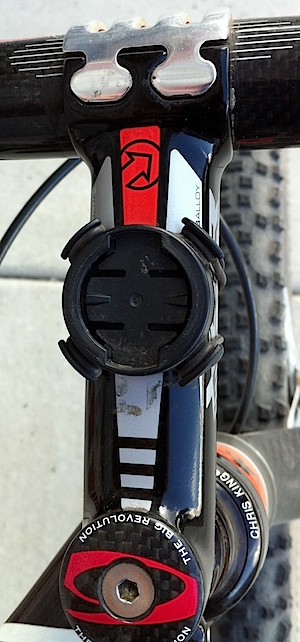 Mounting It: As Easy As Shooting Rubber Bands
Mounting It: As Easy As Shooting Rubber Bands
I am not good with tools. In fact, I tend to get sweaty and panicky when I have to do any bike maintenance beyond lubing the chain. And I am not too proud to say that I have ruined more than one bike computer simply by trying to mount it on my bike.
So when I got the Edge 500, I wasn’t looking forward to setting it up on my bike.
Until I found out that setting up the mount requires exactly no tools and — at most — two minutes of your time.
Essentially, all you have to do is rest the mount where you want it on your stem, then stretch a couple of industrial-strength rubber bands under the stem, diagonally from corner to corner.
That’s it. That’s all there is to it.
At first I was a little bit concerned — would a couple of bands be enough to secure a GPS? Well, I’ve had this GPS mounted to the stem of my fully-rigid singlespeed for the whole season, for every mountain bike ride, for the Kokopelli Trail, for the Leadville 100, for the PCP2P, and for several hometown epics, and the mount has never slipped. No band has ever broken.
Simple solutions are sometimes the best.
So, how do you attach the actual Edge 500 onto this little mount? By putting it on sideways, and then turning it a quarter turn, locking it into place. Takes no time at all, and it stays put, nice and secure.
Oh, and here’s a nice touch with the mounts: the Edge 500 comes with two mount kits, not just one. Which means that you can set one up on your mountain bike and one on your road bike, then easily move the computer between the two bikes.
Which is exactly what I do.
So now I’ve gone on for about ten paragraphs about the Edge 500’s bike mounts. But the fact is, setting up and moving the computer is a huge — and until now, problematic — part of how you use your bike computer. With the Edge 500, setting up the mounts and moving the computer between mounts is truly, genuinely simple.
Information Overload
It’s nothing new to have a lot of information available on your GPS, and the Edge 500 can provide a ton of data: Speed, temperature, time, time of day, total ascent and descent, vertical speed, cadence, calories, distance, elevation, grade, heading, heart rate, laps, and power, along with various permutations of practically all of the above.
What I like about the Edge 500 is how easy it is to customize how much data you see, what data you see, and how you can easily change what you see.
For example, for most of the Leadville 100, here’s the screen I was looking at:
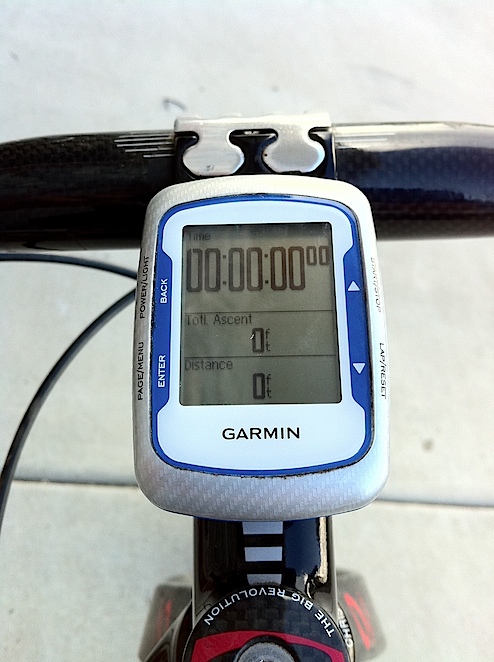
Three fields, nice and big, showing just what I cared about: how long I’d been out, how much climbing I had done, and how far I had gone.
With a single button press (the Page / Menu button on the bottom-left side), though, I could go to a different custom page with eight fields:
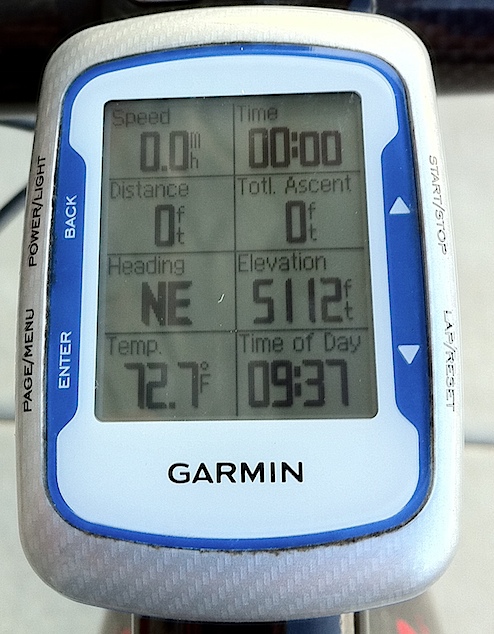
Cuz sometimes you just want to let your inner nerd out.
Other Stuff I Love About the Edge 500
There are other things I like a lot about the Edge 500 — things that make me think that Garmin really did their homework for what a cyclist would want from a GPS bike computer:
- It’s easy to use even with gloves on. The buttons are on the side, and are rubberized and clicky. There’s enough tactile feedback with these that even with full-finger gloves on, I have no problem operating this thing.
- It’s smart. If you turn the Edge 500 on but forget to press Start, it notices when you’ve started rolling. It chimes and prompts you to press Start. I don’t even know how many times at the beginning of a ride (or race!) I forget to press Start when I get going. This little reminder has come in handy dozens (at least!) of times.
- It’s helpful. The first time I went to customize the fields, I didn’t know whether I would be able to figure it out. To my surprise, the Edge 500 actually walked me through the process, telling me what steps came next. Like this:
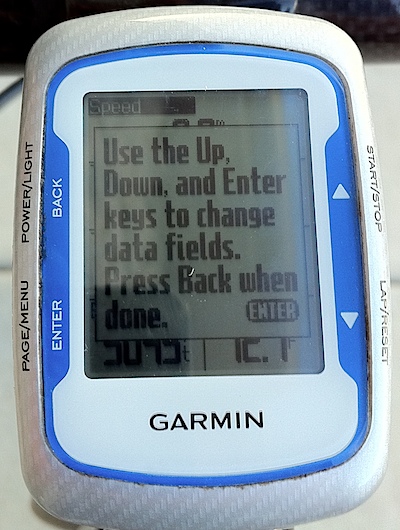
Yep, a bike computer that doesn’t assume you keep the arcane instruction book with you at all times. What a concept.
- It’s long-lasting. The specs for the Edge 500 say the battery life is up to 18 hours. Honestly I haven’t tried running it that long. But I have run it for twelve hours at a time, several times.
- It’s easy to charge. The Edge 500 comes with an AC charger, but it also can be charged from any USB port, which is what I always do. Which means that as long as you can find a computer, you can charge your Garmin. That’s not a big deal, until you forget your charger at home, and then it’s really nice to be able to not have to look for an obscure cable to recharge your bike computer.
- It’s got a backlight. If you’re riding early in the morning or late at night, that’s nice to have.
If you’re looking to quantify your cycling experience, I daresay this is a really nice way to do it. And, in short, I love the Garmin 500.
Enough so that I bought a second one for The Runner to use on her bikes.
Comments (75)
09.21.2010 | 11:08 am
A Note from Fatty: This is the first in a series (of indeterminate length, because I don’t think very far ahead, and I don’t know whether people will like these) of posts about bike-related stuff that I own and love. These posts are not reviews, because reviews are generally about new products and need to at least pretend to be balanced in coverage. Instead, these posts are about stuff I have had long enough that I’m way past certain that they’re awesome, and hence want to tell my friends about them.
In April of 2009, I wrote a post titled, “An Open Letter to Specialized.” In it, I pretty thoroughly trashed their mountain bike shoes, saying that while the shoes fit great, they just didn’t last; with them I had had to purchase new mountain bike shoes every other season.
I said that Specialized had worn out their welcome, shoe-wise, and finished with an open appeal to any shoe manufacturer that would like to earn a loyal customer.
Two companies sent me new mountain biking shoes. Sidi sent me their top-of-the-line Dragon 2 SRSs. Here they are, back when they were new:
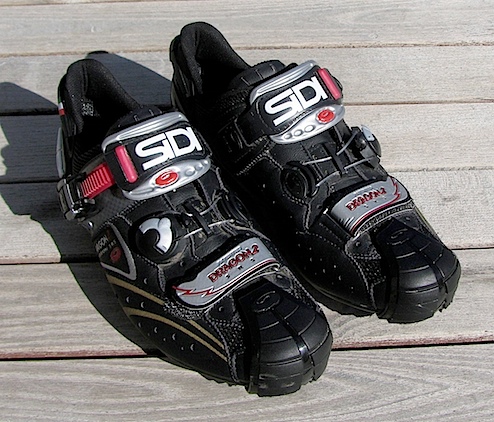
And — to my huge surprise — Specialized stepped up in the face of ridicule and sent me a new pair of their Specialized BG Pro Carbon MTB shoes. Here they are when they were new:
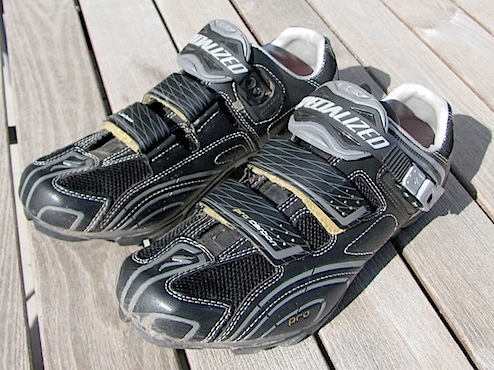
The Evolution of Preference
I told myself that the fairest way I could decide which pair of shoes — if either — I liked best would be to switch on a ride-by-ride basis. The thing is, I knew that system wouldn’t last forever. At some point, I knew I’d start using one pair of shoes more often than the other. And that, probably, I’d wind up wearing one of those pairs pretty much exclusively.
I should also point out that I started out hugely biased against Specialized; they had already failed me and were on double-extra-secret probation, as far as I was concerned.
And besides, the Sidis were the cooler, sexier brand, and were way (like double) more expensive.
So, in short, I was pretty sure that Specialized was going to take a drubbing, handing me one of those oh-so-rare-and-delicious “I told you so” moments.
You can already tell where this is going to wind up, can’t you?
Well, just in case you can’t, take a look at the shoes now that I’ve had them for about two riding seasons:
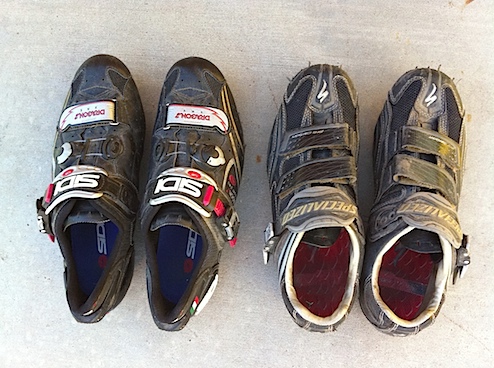
Yeah, the Specialized shoes look like they’ve been used a lot more, don’t they?
I’m surprised too. It’s because these shoes are used a lot more, by the way — not that they wear out fast.
The truth is, I was pretty good about switching between the shoes for about a month — long enough to realize that both brands of shoes are very good.
But while I like the way the Sidis look and fit, I simply love my Specialized BG Pro shoes.
And here’s why.
No Maintenance
My previous pairs of Specialized shoes all self-destructed within a couple of seasons, which is a huge problem, considering how expensive cycling shoes are. But after a couple of seasons, here’s how this pair looks from the side:
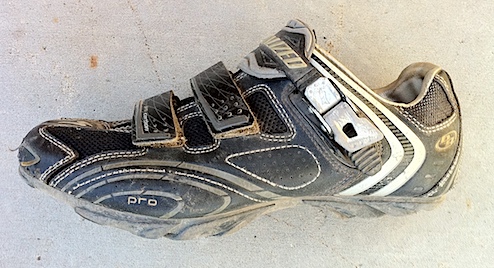
And here’s the sole:
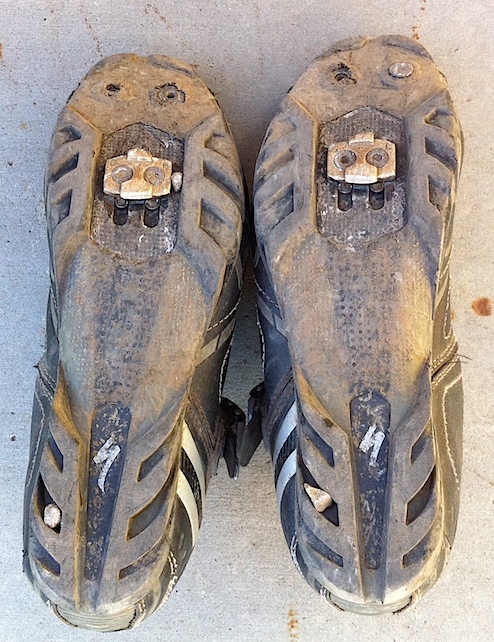
Obviously, these shoes are scuffed and dirty (and it’s high time I replace my cleats). If you look past those things, though, you’ll note that the shoes are completely intact. The mesh on the uppers is in great shape (in spite of the fact that I have not cared for them at all), and the soles are still intact. I can also tell you that the velcro still fastens securely and the ratchet on both shoes works flawlessly.
In other words, these shoes are in as good of shape after two seasons of a lot of riding as when I got them. Without my ever doing anything to take care of them.
And I have no reason to suspect they won’t be good for at least another season or two of lots of riding.
Comfort
One thing I have never complained about — and in fact have praised, multiple times — is the Specialized “Body Geometry” system. Specialized has clearly spent a lot of time and money researching how feet fit in shoes.
As a result, my feet have never hurt when mountain biking this season. And that’s saying something, considering I have worn these shoes on some pretty long rides, including:
- The Kokopelli Trail
- The Leadville 100
- The Park City P2P
- Several hometown all-day epics
No hotspots. No aching arches. No soreness or blisters. Ever. My feet are the one part of my body that have never endured even a second’s worth of discomfort this riding season.
The fact is, once I put my shoes on, I never think about my feet the rest of the ride.
Which I think is about as high of praise as you can have for mountain bike shoes.
Matchy-Matchy
I’m now a big enough fan of Specialized shoes that last weekend I took The Runner out to a bike shop and bought her an equivalent pair of these shoes (but much, much smaller, because The Runner’s feet are dainty). I think that’s worth pointing out because while it’s one thing to like something that’s given to you for free, my endorsement might be more credible when you know that I am also willing to buy them at retail.
So, Specialized, we kind of took the long way ’round on this relationship, but I think it worked out pretty good for both of us in the end. You’ve won me back. I love you guys.
Now c’mon over here and give me a hug.
Comments (53)
« Previous Page — « Previous Entries Next Entries » — Next Page »
 You Can Also Win a Trip to Austin to Join Team Fatty for the Ride for the Roses
You Can Also Win a Trip to Austin to Join Team Fatty for the Ride for the Roses












